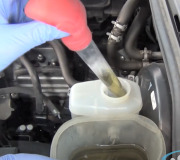Never, never, ever push the pedal more than half way to the floor. Doing so will run the pistons in the master cylinder through the lower halves of the bores where they don't normally travel. Crud and corrosion can build up there. Running the lip seals over that can rip them.
Pedal-bleeding with that helper is the fastest and most effective, but I have to resort to gravity-bleeding. Brake fluid must remain in sealed containers because it loves to suck moisture out of the air which lowers its boiling point and promotes corrosion, but you'll need to crack open the master cylinder cap a little so vacuum doesn't build up as the fluid leaves. If the fluid doesn't start running on its own after a minute or two, "irritate" the brake pedal a little to get it started. When fluid is dripping from one wheel, close that bleeder screw and wait for the next one. When all of them are bled, work the pedal, never more than halfway to the floor, to move the caliper pistons out. You'll feel the pedal get hard when the pads contact the rotors. Any remaining air bubbles will wash into the calipers and wheel cylinders. Open each bleeder once more for a few seconds to get the last few air bubbles out.
If the brake fluid doesn't start running out on its own, you have that vacuum bleeder to get things started. A real common problem with vacuum bleeders is they pull air past the bleeder screws' threads so it always looks like you have more air in the system. They work nice for replacing the old brake fluid with new when it is known there is no air in the system but we rarely do that recommended service.
Be absolutely certain you don't get any petroleum product in the brake fluid. No penetrating oil to get rusty bleeder screws freed up. No wheel bearing grease residue on your fingers when you poke the rubber bladder seal back into the reservoir cap. No power steering fluid or transmission fluid. Don't set the reservoir cap on a grease-covered engine.
Saturday, June 23rd, 2012 AT 6:38 PM



